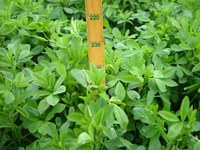Methods Available to Estimate Forage Quality
(Click the image below to view a high-resolution image that can be downloaded)
Neutral detergent fiber concentrations can help producers determine when to harvest alfalfa as feed for dairy cows, according to North Dakota State University Extension Service dairy specialist J.W. Schroeder.
Neutral detergent fiber (NDF) is the most common measure of fiber used for animal feed analysis. The level of NDF in the animal ration influences the intake of dry matter and the time of rumination.
Delaying the alfalfa harvest increases the NDF percentage and reduces protein concentration, which means more grain will be required to increase energy density and decrease the NDF concentration (and filling effect) of the diet, Schroeder says. In addition, more supplemental protein will be required to meet the cows’ protein requirements, and dry-matter intake and milk production will be reduced.
Several methods have been proposed to predict the timing of the first-cutting alfalfa harvest based on NDF concentration. At the farm level, procedures need to be easy to use, require minimal time and provide relatively accurate predictions of the NDF concentration of the alfalfa to be fed, Schroeder says. Here is a short description of each:
- Scissors-cut samples: They provide a direct measurement of NDF in the collected plant material. Sampling technique is critical. A representative sample must be obtained from across the field. Sample handling is also important to minimize respiration losses prior to the sample arriving in the analytical lab. In addition, errors can occur with near-infrared reflectance spectroscopy analysis of scissors-cut samples because equations for fresh alfalfa are not generally available. Scissor-cut programs have not been used in North Dakota.
- Growing degree days (GDD): The GDD calculation for alfalfa is based on the minimum and maximum daily temperature beginning on March 1 using a base of 41 F. The daily calculation is [(maximum temperature + minimum temperature)/2] – 41. The total GDD is the sum of the positive daily GDD values across days beginning March 1. Predicting NDF concentration using GDD cannot be done when soil moisture is inadequate because GDD accumulate with little or no response in plant growth. Consequently, GDD have been used only for the first-cutting alfalfa harvest.
- PEAQ (predictive equations for alfalfa quality): This method is based on an equation that uses the length of the tallest alfalfa stem and the stage of the most mature alfalfa plant (these likely will be two different plants) in the area sampled. The current modified PEAQ method uses a scale of three stages of maturity (late vegetative, bud and flower). Measuring sticks, calibrated for the three plant maturity stages, are used to obtain estimates of NDF.
The PEAQ and GDD methods were developed for pure stands of alfalfa. The NDF estimates from the PEAQ will not account for weeds or grasses in the stands, Schroeder says. Also, the PEAQ is not reliable for estimating NDF when alfalfa is very short (longest stem is less than 16 inches) or very tall (longest stem is more than 40 inches).
He has these research-based recommendations:
- Use the PEAQ stick or GDD to predict NDF for the first-cutting alfalfa harvest. Only the PEAQ stick should be used for the second cutting. Do not use the PEAQ or GDD method for the third cutting.
- Begin cutting alfalfa at 40 percent NDF (750 GDD, base 41 F) for upright silos and 38 percent NDF (680 GDD, base 41F) for horizontal silos. Start even earlier for horizontal silos if finishing the harvest takes more than a week.
- Do not use the GDD and PEAQ methods for fields containing grass.
- Harvest fields containing grass first. Start with the fields with the most grass and finish with the purest alfalfa fields.
- Consider using the scissors-cut method for fields containing grass and for the third-cutting alfalfa harvest. Shipping samples to the analytical lab by next-day delivery will help minimize deterioration in sample quality. Wet chemistry analysis is most appropriate for scissors-cut samples.
NDSU Agriculture Communication
| Source: | J.W. Schroeder, (701) 231-7663, jw.schroeder@ndsu.edu |
|---|---|
| Editor: | Ellen Crawford, (701) 231-5391, ellen.crawford@ndsu.edu |


